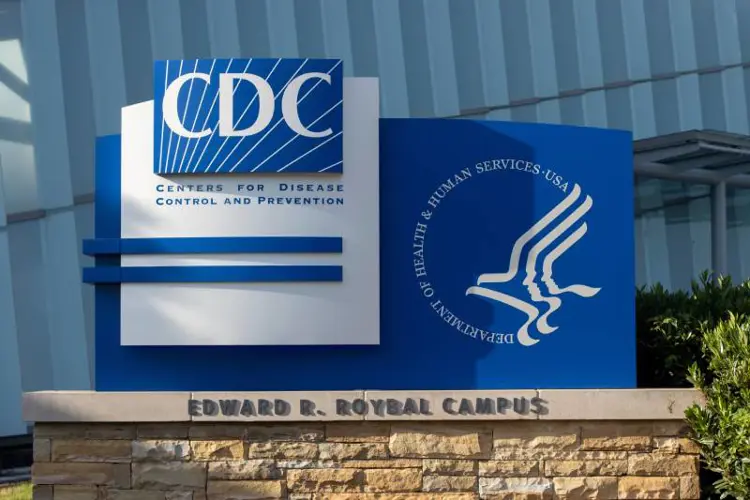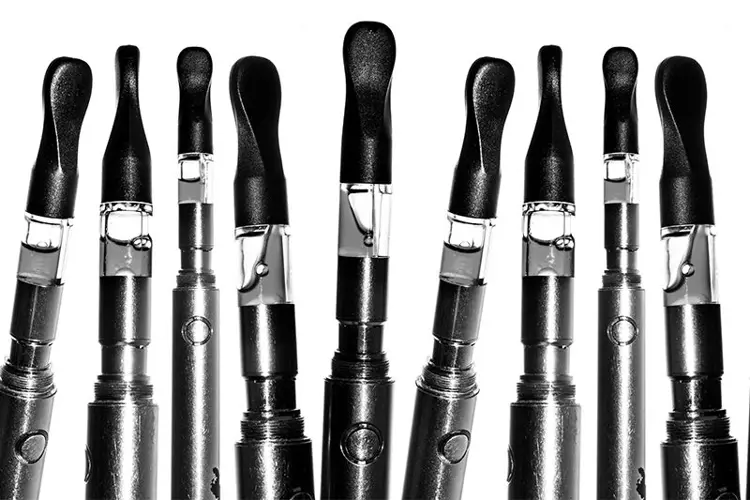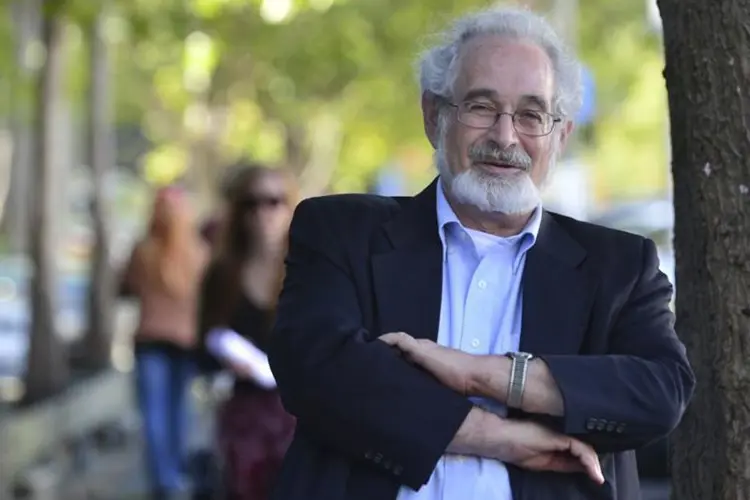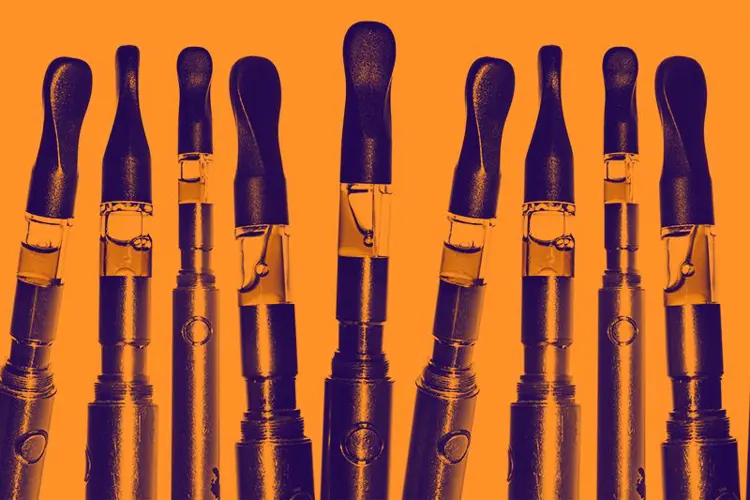The lung injuries called "EVALI" by the CDC were not caused by commercial nicotine vapes, but by adulterated THC oil sold on the black market. Illegal producers of prefilled THC cartridges diluted the hash oil with cutting agents that consisted mostly of vitamin E acetate (also known as tocopherol or tocopheryl acetate), a flavorless, odorless, oil-soluble substance with almost the same consistency as THC oil.
CDC did not have to wait to act until it identified the exact substance in illicit THC products that had caused the lung injuries. The agency should have issued an alert specifying where the likely danger lay, even if there were legitimate concerns that vitamin E acetate wasn’t the only potential source of risk.
Reporters, cannabis industry experts, vaping advocates, bloggers, doctors, and non-CDC researchers around the country raised alarms over vitamin E acetate for more than two months before CDC decided to specify the substance in its alerts—and even after that, the agency continued to warn that other constituents in cannabis and nicotine vapes might be at fault. What CDC did was the exact opposite of prudent public health strategy.
CDC officials spent considerable time crafting a clever name and acronym for the lung injuries—one that confused both cannabis and nicotine vapers—which probably resulted in many more injuries and deaths than would have happened if they had simply and promptly warned all vapers of what the likely dangers were. Now most Americans believe that commercial nicotine vapes are responsible for the lung injuries, which will lead to untold numbers of cigarette smokers never trying vaping products, and eventually suffering disease and death from smoking.
Even in the agency’s final February 2020 public communication regarding “e-cigarette, or vaping, product use-associated lung injury,” CDC refused to give up on nicotine vaping being at least partly responsible. “Evidence is not sufficient to rule out the contribution of other chemicals of concern, including chemicals in either THC or non-THC products, in some of the reported EVALI cases,” the agency wrote—even though not a single commercial nicotine vaping product was ever implicated in a diagnosed case of “EVALI.”
In tribute to the intrepid CDC "disease detectives"—who took till November to figure out what Leafly reporter David Downs had guessed correctly in August—we have created a timeline of lung injury news events. Follow along on this virtual walk down "EVALI" memory lane, and see who knew what, when they knew it, and what CDC officials were saying during the period between the first known lung injuries in July and Nov. 8, the day the agency finally acknowledged that vitamin E acetate was primarily responsible.
A timeline of CDC's response: delay, deception, denial
July 25
- Wisconsin Department of Health Services memo to healthcare providers: Severe Pulmonary Disease Among Adolescents who Reported Vaping
"DHS is currently investigating the possible cause of these illnesses. All patients reported vaping in the weeks and months prior to hospital admission. The names and types of products used remain unknown, and patient interviews are ongoing. Clinicians are encouraged to remain alert for potential cases among persons presenting with progressive respiratory symptoms who report a history of inhalation drug use, particularly vaping."
Aug. 8
"'Inhalation drug use' is not typically a phrase used to describe regular vaping of nicotine (or zero-nicotine) e-liquid. That seems to indicate that the DHS officials already suspected that the kids were using something other than standard vaping products."
Aug. 12
- California Department of Public Health: CDPH Health Alert: Severe Acute Pulmonary Disease Associated with Cannabis or Cannabidiol Oil Vaping
“A reported common exposure among these patients is that they have been vaping cannabis or cannabidiol (CBD) oils. At this time, no infectious cause has been identified.”
Aug. 16
“Teske and a Kings County public health investigator reviewed all seven case files and conducted follow-up interviews with patients in the hospital and at home. A common theme emerged—all had been using vape carts bought off the street around Kings County, in rural Central California. All reported doing it to save money. They were buying them at local, unlicensed pop-up markets, advertised by word of mouth.”
Aug. 19
“I placed an order for 20 Dank Vapes cartridges to be delivered to my New York City apartment. Within hours, I got a text message seeking payment and a confirmation email. In other words, this Dank Vape dealer (who assured me that all the Danks were real) had no problems at least saying they would ship across state lines.”
Aug. 23
- Brian King of the CDC Office on Smoking and Health, speaking on a joint CDC-FDA call with reporters
“So there’s a variety of harmful ingredients identified [in nicotine vaping products], including things like ultrafine particulates, heavy metals like lead, and cancer causing chemicals. And flavoring used in e-cigarettes to give it a buttery flavor, diacetyl, and it’s been related to severe respiratory illness. That being said we haven’t specifically linked any of those specific ingredients to the current cases but we know that e-cigarette aerosol is not harmless.”
Aug. 27
- Dr. Michael Siegel (National Review): CDC’s Bias Against E-Cigarettes Is Putting Kids’ Lives at Risk
“Unfortunately, there is such an anti-vaping prejudice — and a growing bias against the use of e-cigarettes for smoking cessation — that many are hoping to be able to attribute these cases to traditional nicotine vaping. Since there has been no specific admonition to avoid THC oils, and no real effort to distinguish between nicotine e-cigarette liquids and other chemicals, kids are not going to understand the immense difference in danger. This is a failure of the CDC — and one that puts lives at risk.”
Aug. 28
“Marijuana oil vaping was cited in at least 21 cases of severe lung illness reported by the San Francisco Chronicle last week. In Utah, officials said marijuana oil was a likely culprit in most cases of lung illnesses in teens. A Wisconsin man had so much trouble breathing after he vaped nicotine and THC oil that doctors put Dylan Nelson into a medically induced coma and hooked him up to a ventilator.”
“The pattern is clear: reporters from cannabis publications and California news outlets grasp the issue immediately, but national news reporters and federal officials are hamstrung by their preconceptions. And in the case of the CDC, officials like Brian King have used the outbreak as a hook to repeat the same list of mights and maybes they’ve been using for almost a decade to demonize nicotine and vaping. They know better, but they do it anyway.”
Aug. 30
“Industry insiders who track the legal and illegal vape cart markets closely tell Leafly that a new type of additive started showing up in late 2018, and has since become widely used in underground markets. It’s a novel class of odorless, tasteless thickening agents. These liquids come in different proprietary formulations manufactured by both legal, above-board companies and by shadowy underground operations.”
Aug. 31
“Whatever the agencies say, the words they use cause problems of their own. The FDA statement contains 22 uses of the term “e-cigarette.” The official CDC health advisory used it 45 times.
“Most people who call their favorite products “e-cigarettes” are vaping nicotine, not black market THC oil. The insistence by these public health agencies that the current outbreak of lung damage has been caused by e-cigarettes is likely to frighten vapers back to smoking, or prevent smokers from trying what is known to be a much safer product.
“Additionally, many cannabis oil users would not even recognize that term as applying to the products they use, which are typically called oil cartridges, vape carts, THC carts, vape pens, weed vapes, or some variation on those phrases. None of those terms are used even once in [Acting FDA Commissioner] Sharpless’ statement.”
Sept. 5
“The state said that the vitamin E compound was found in tests of cannabis products, but not in the nicotine-based products it tested, a finding consistent with reports from doctors that many illnesses have been linked to people using a vaping device for marijuana.”
“For weeks, officials have searched for what could be causing a string of vaping-related respiratory illnesses across the country. Now, they may have found a clue: Many of the products used by the patients contained a common contaminant — an oil derived from vitamin E, according to news reports.”
“As of August 27, the US Centers for Disease Control and Prevention said it was aware of at least 215 possible cases in 25 states of severe lung disease that could be caused by vaping — with additional cases still under investigation.
“The CDC has yet to identify a single product that could be responsible, ‘although THC and cannabinoids use has been reported in many cases,’ the agency said.”
- Dr. Michael Siegel: ALERT: Major Breakthrough in Investigation of "Mysterious" Lung Disease Outbreak
“The truly unfortunate rest of the story is that in their zeal to demonize e-cigarettes, the CDC and other health agencies have put the lives of our nation's youth at risk. They should have issued a warning 11 days ago. During the past 11 days, how many youth continued to vape THC oils because of the failure of health agencies to accurately convey the known information about the potential causes of the outbreak? The CDC and other health agencies and some anti-tobacco groups have gone to great lengths to protect the illicit cannabis industry. But they have no problem with attacking the e-cigarette companies and telling ex-smokers to return to smoking rather than continuing to vape. Why?”
Sept. 6
“The popular illicit market diluent thickener Honey Cut, based out of Los Angeles, may contain vitamin E oil, according to independent tests by the Portland, Oregon, terpene maker True Terpenes, and Jones. Leafly previously chronicled Honey Cut’s introduction in Los Angeles in late 2018 and its subsequent dominance of the market for vape cart cutting agents.
“As of today, Honey Cut’s previously functioning website at honeycutvapes.com has disappeared. Error notices have taken its place. Honey Cut officials have not responded to Leafly’s requests for comment.”
“What’s the takeaway? Illicit vape producers work under the radar, and their products don’t undergo any testing until people start dying from them. Stick to the legal products, since those undergo mandatory testing, and licensed producers are subject to heavy fines or criminal prosecution if they cheat the system.”
“If you own illicit vape cartridges, throw them away immediately.”
“‘We don’t know what we’re looking for,’ an official at the Centers for Disease Control and Prevention, which is leading the investigation, said last week.”
“Also clear is that commercial nicotine vaping products are not responsible for the outbreak of lung injuries. But the FDA and CDC continue to warn against vaping any product, and refuse to make a direct statement implicating what appears the most likely cause. As we reported last week, federal officials persist in using language that confuses the public, rather than using the terms users of all vaping products understand.”
“The CDC said Friday, however, that ‘no one device, product or substance has been linked to all cases.’"
Sept. 9
“Jones said the product is very popular. He estimated that as much as 70% of the vape cartridges in America’s illicit cannabis vape cart market contain tocopheryl-acetate. Floraplex officials told Leafly they estimate 50 million cartridges with ‘some form of vitamin E oil’ are on the street.”
- New York State subpoenas manufacturers of vitamin E acetate-based cutting agents
“While the investigation is still ongoing, laboratory results have shown very high levels of vitamin E acetate in nearly all cannabis-containing samples analyzed by the [state health department lab].”
Sept. 10
“E-liquid for nicotine (or non-nicotine) vaping doesn’t contain thick cutting agents, which are as dense as cannabis oil itself and would be useless in liquid-based vape juice. But that hasn’t prevented public officials from trying to conflate the two products as the death toll climbed to five in the nationwide outbreak.”
Sept. 13
“No similar pattern of pulmonary illness has emerged in the UK. Unlike the US, all e-cigarette products in the UK are tightly regulated by the Medicines and Healthcare products Regulatory Agency (MHRA). The agency operates a ‘yellow card’ scheme that collects adverse reactions associated with nicotine-containing e-cigarettes and encourages vapers to report any health problems.
“The MHRA tells Chemistry World that it received 12 spontaneous yellow card reports of adverse reactions associated with nicotine-containing e-cigarettes between late August 2018 and late August 2019. However, based on the evidence reported in these cases, the agency says it does not consider these reports to indicate severe or dangerous lung injury similar to those reported in the US.”
Sept. 17
“At Redmond, Washington-based cannabis testing facility Confidence Analytics, Laboratory Director Shannon Stevens said her company is developing a method to test for vitamin E acetate in the wake of reports that more than 450 people had become ill and that some were dying.
“‘We started working on this pretty much immediately,’ she said.”
- San Jose Mercury-News: Why did vaping leave one Californian dead and dozens more hospitalized?
“Some cannabis labs are adding optional product tests for vitamin E acetate, while licensed companies are scrambling to verify ingredients in their vape products and to communicate that information with their customers.”
Sept. 24
“As the world now knows, a multi-billion dollar marketplace exists for illicit THC vaping devices and cartridges. Millions of street consumers use them, and unlike vape carts purchased in state-licensed medical marijuana dispensaries and cannabis stores, illicit products lack regulation and mandatory testing for potency or purity. Recent reports have estimated that America’s legal, regulated cannabis industry accounts for only 22% of the nation’s $52 billion in cannabis purchases. The other 78% of the THC market remains untested and out of control.”
Sept. 25
- Metro Times (Detroit): Michigan’s war on teen vaping is clouding the issue of deadly black-market cannabis
“On its website, [the Michigan Department of Health and Human Services] dedicated an entire section to vaping, but the only mention of marijuana cartridges is on one page of a 71-page slide show, which fails to address the link to cannabis oil.
“As health officials scramble to get a handle on the outbreak, investigators are increasingly focusing on vitamin E acetate, an agent used to dilute and thicken THC oil in black-market cannabis vape cartridges.”
Sept. 27
“Of the three purchased from legal dispensaries in California, the CannaSafe testing company found no heavy metals, pesticides or residual solvents like vitamin E.
“But 13 out of the other 15 samples from black market THC cartridges were found to contain vitamin E.”
Oct. 4
“While the FDA does not have enough data presently to conclude that Vitamin E acetate is the cause of the lung injury in these cases, the agency believes it is prudent to avoid inhaling this substance.”
Oct. 11
- Rolling Stone: There’s Not Just One Vape Crisis — There’s Three
“The CDC has been quick to caution that not all of the victims had a history of THC cartridge use, nor have all of the samples tested positive for vitamin E acetate.”
Oct. 17
“But because the cause of the lung illnesses remains unclear, ‘the only way to assure that you are not at risk while the investigation continues is to consider refraining from use of all e-cigarette, or vaping, products,’ the CDC says on its website.”
Oct. 23
“As expected, tocopheryl-acetate turned up in most samples of oil from the street. Commonly dubbed vitamin E oil, chemists and toxicologists tell Leafly that when smoked and inhaled, the otherwise benign food supplement and cosmetics ingredient blocks the lungs’ ability to absorb oxygen, triggering chemical pneumonitis, hypoxia, and, if untreated, death.
“Anresco Labs found tocopheryl-acetate levels as high as 34.9% in an Exotic Carts variety called Mars OG, meaning that more than one-third of the entire cartridge consisted of a suspected lung toxin. The suspected counterfeit Brass Knuckles cartridge tested at 33% tocopheryl-acetate.”
Oct. 25
- Utah medical doctors and researchers: E-cigarette Use, or Vaping, Practices and Characteristics Among Persons with Associated Lung Injury — Utah, April–October 2019
“To date, UDOH and Utah local health departments have collected 72 products from eight (15%) of 53 patients interviewed. Products tested at UPHL comprised 19 prefilled THC-containing cartridges from six patients and 20 nicotine-containing vaping liquids (19 bottled e-liquids and one from an atomizer) from six patients; six patients provided both THC- and nicotine-containing samples, and two provided only nicotine-containing samples). Among the 19 THC-containing cartridges, THC was detected in 19 of 19 (100%), nicotine was detected in one (5%), and evidence of vitamin E acetate was detected in 17 (89%). Samples of nicotine-containing e-liquid, in contrast, only showed evidence of nicotine and no evidence of THC or vitamin E acetate. No other analytes were found.”
- Dr. Anne Schuchat of CDC on joint FDA-CDC call with reporters
“Although these new data continue to point to THC exposures as important, at this time FDA and CDC have not identified a single specific compound, substance, product or brand that is causing these lung injuries. And it may be that there is more than one cause of the lung injuries in this outbreak. As such, we recommend that you do not use e-cigarette, or vaping, products that contain THC. And since the specific compounds or ingredients causing lung injury are not yet known, the only way to be sure that you are not at risk is to consider refraining from use of all e-cigarette, or vaping, products while our investigation continues.”
“But I’d like to stress that we don’t know what the risky material or substance is. THC may be a marker for a way that cartridges were prepared or way that the devices are producing harm. Whether there are similar activities going on with cartridges that don’t contain THC, for instance, remains to be seen. So, I think we are seeing the THC as a marker for products that are risky. But at this time because of the continued presence of cases that only report exclusive nicotine-containing e-cigarette or vaping product use, we feel it is very important for people to consider refraining from use of any kind of e-cigarettes.”
Oct. 29
“The CDC seems to be using the lung injury outbreak as a way of encouraging—or at least enabling—local and state bans and restrictions on nicotine products. Seven states have banned flavored vaping products since the outbreak began, mostly in direct response to the lung injuries or at least using them as a secondary reason. The Trump administration has also proposed a federal flavor ban. But flavors in legal vaping products have nothing to do with these injuries.”
Oct. 30
“The clear link between THC containing products and EVALI has been apparent since nearly the beginning, when cases were first reported in Wisconsin this August. And health officials in some states have been more overt in making a connection between the majority or all of their cases and THC products sold on the black market. CDC officials on the other hand have been more cautious in their wording, often only going as far as to state that THC products may play a role.”
Nov. 8
- New York Times: Vaping Illnesses Are Linked to Vitamin E Acetate, C.D.C. Says
“‘For the first time, we have detected a potential toxin of concern, vitamin E acetate, from biological samples from patients,’ with lung damage linked to vaping, Dr. Anne Schuchat, principal deputy director of the Centers for Disease Control and Prevention, said at a news briefing.”
“Although most cases of the vaping illness have been linked to illicit THC, Dr. Schuchat said that did not mean other vaping products could be considered safe. She said there were anecdotal reports, not yet fully investigated, of patients who said they had bought THC from licensed dispensaries in states where marijuana is legal.
“Nicotine has not been exonerated, either. Some patients say they vaped only nicotine, and state health officials consider some of those reports reliable, Dr. Schuchat said.”
“Considering vaping has been around for more than a decade with tens of millions of users across the world, and no such outbreak had yet occurred, it should’ve been clear to the CDC that something other than nicotine was responsible. It should’ve been especially evident since the U.S. is the only country in the world where this outbreak is occurring—despite e-cigarettes being widely available in places such as Canada and Europe.
“But the CDC persisted in saying it couldn’t rule out regular e-cigarettes as a cause of the outbreak. As late as Nov. 1, the CDC advised: ‘because the specific compound or ingredient causing lung injury is not yet known, and while the investigation continues, persons should consider refraining from the use of all e-cigarette, or vaping, products.’
“The damage done by the CDC’s miscommunication can’t be overstated. In September, Reuters released a poll showing 63 percent of adults disagreed with the correct statement that ‘vaping is healthier than traditional cigarettes.’ That number is up 16 percentage points from 2016.”
“Today's announcement confirms that in fact, the CDC's failure to appropriately warn the public about the role of THC vape carts in this outbreak, and the same failure among many state health departments, has almost certainly led to additional cases of the illness that would not have occurred if they had not used the outbreak as an excuse to demonize e-cigarettes. How many lives could have been saved and how many severe illnesses averted if they had simply told the truth from the beginning?“
The Freemax REXA PRO and REXA SMART are highly advanced pod vapes, offering seemingly endless features, beautiful touchscreens, and new DUOMAX pods.
The OXVA XLIM Pro 2 DNA is powered by a custom-made Evolv DNA chipset, offering a Replay function and dry hit protection. Read our review to find out more.
The SKE Bar is a 2 mL replaceable pod vape with a 500 mAh battery, a 1.2-ohm mesh coil, and 35 flavors to choose from in 2% nicotine.
Because of declining cigarette sales, state governments in the U.S. and countries around the world are looking to vapor products as a new source of tax revenue.
The legal age to buy e-cigarettes and other vaping products varies around the world. The United States recently changed the legal minimum sales age to 21.
A list of vaping product flavor bans and online sales bans in the United States, and sales and possession bans in other countries.


















